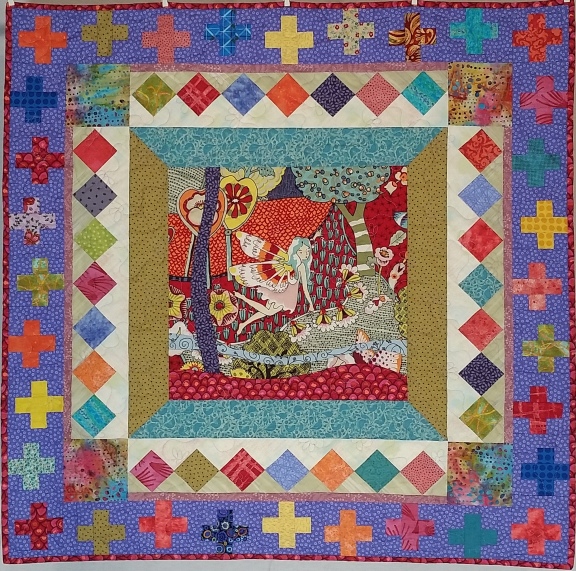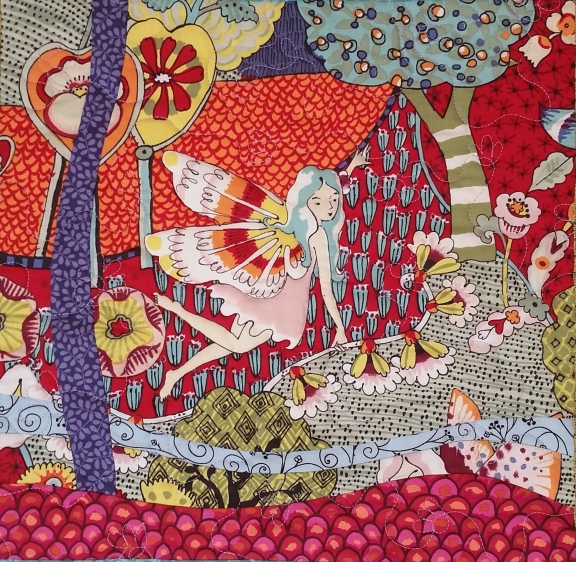In April and May I taught my Medallion Improv! class at one of my favorite local shops, Inspirations in Hills, IA. The purpose of the class is to teach students to create medallion quilts of their own design. I provide a “template” for them to use if they choose, which helps with border and block sizes. In addition they each get a workbook I wrote with design information and ideas, as well as construction pointers.
One of the main features of the class is the “workshop,” or providing feedback to each other on our work so far. We each show what we’ve done and discuss our thinking, as well as possibilities for changes and additions. The other members of the group give ideas and comparisons. The comments help eliminate some options and expand others.
To help them visualize different solutions to the many challenges medallions can offer, I make two quilts that are very different from each other. Recently I finished the second one and now have pictures of it.

I Found the Housework Fairy But She’s Not Coming Back. 35″ square. Finished June 2015. Photo by Jim Ruebush.
I began this quilt with a piece of fabric. Last fall when Jim and I visited Taos, NM, I purchased a half-yard of Alexander Henry fabric. On one side of the width was one fairy, and on the other side were two grouped together. For this quilt I chose the side with only one. To fit the center block size of the template, I cut it to a 15″ finish. After cutting, I decided I wanted to use curved insets. The insets frame the fairy with lines that continue across the block, allowing easier focus on the fairy herself. Of course, adding the insets messed substantially with the sizing, and I was lucky to get it back to 15″ finish. Lesson learned: add insets before cutting to size.
The first border is 2.5″ wide. It is very simple, again intended to draw attention to the fairy. The avocado green and turquoise strips are mitered to draw lines directly to her.
The next border stumped me, but here the class helped. Using a large design wall, I auditioned a number of fabrics and ideas. Phyllis asserted that the pale fabric was my best option for next color. But at home I tried various solutions and still wasn’t convinced. Finally I told myself to think like my sister Cathie. Her approach is somewhat different from mine, and she gets great results. If I could be more flexible in my thinking I could meet this challenge.
I decided to put squares on point, but make them smaller than the width allowed. That meant more squares and a little more delicate feel. But I needed to figure out how to fill the width. I chose having a darker color outside and extra of the very light color next to the center. Also because all the squares and their setting pieces are on the bias, a strip of lavender on the outside edge stabilizes it and gives it a more defined finish. I tried a variety of corner blocks before choosing the multi-colored batik.
The third border is 3.5″ wide, taking the top to 35″ finished. I like the plus blocks. The floated setting shows off each block and also provides an airier feel than would be achieved if the blocks were set against each other. I’ve described my decisions for that border pretty completely here, so won’t repeat all of it.
My class blueprint takes the quilt to a 60″ square. Once I finished the third border, I tried two completely different approaches to the fourth one. Neither worked, and after each attempt I liked the piece better by stopping where it was. So I did.
The final challenge was quilting. The density of the print design in the center still threatened to obscure the fairy. To emphasize her I wanted to hand-quilt around her, rather than quilting right across. I used a small posy edge-to-edge design, with free motion quilting, avoiding her. After the rest of the quilting was done, I did the hand-quilting.

The center with the insets. Quilting isn’t very visible, but perhaps you can see I didn’t obscure her with machine quilting through her.
The binding is the same fabric inset at the bottom of the center block. I’d made it for a different project, but it didn’t work for that one. Fortunately it is just right for this.
The class was wonderfully successful. I had the pleasure yesterday of seeing two of my students’ projects and they are wonderful, startlingly different from each other, and so suited to their makers. My other project for class, Marquetry, was documented here.
Thank you as always for stopping by. I always welcome your comments and questions. If you are making your own medallion and have questions, please feel free to ask.


What a great quilt! I love the witty title, too!
Thanks!
This is so sweet, but I have to admit I really, really like the borders!
Thanks, Janie.
I think the fairy is more “liberated” than Marquetry, and would be wonderful in a child’s room. Marquetry is more grownup and serious. Funny how quilts have personalities.
It is intentionally more liberated, true. Funny and precious that they have their own personalities. Otherwise they would just be blankets! 🙂
I love the shadow box effect around the housework fairy. Your quilts inspire me! Thanks for sharing all you do!”
Thanks, Tammy. I tried that “shadow box” with the greens on adjacent sides, and the turquoises on the other. But it didn’t work that way, so I set them on opposite sides as you see. Thanks for catching that.
It’s fun to read about the decision making, as always, and interesting that the other members of the class were so helpful! Hand quilting around the fairy, to focus on her, sounds like exactly the right choice!
Each group has its own personality, not surprisingly. This class was a little more reticent, but the comments they did make were helpful.
I love the Housework Fairy! (Though it is tragic she is not returning to give you more time to quilt). I love how the combination of the mitered inner border and the lighter fabric inside the on-point squares makes it look like I am looking through an opening into the land of faerie, and the outer purple makes it all so whimsical.
Thank you. I did hope for a view into the garden, so I appreciate that came through.
I’m so glad you quilted to emphasize the fairy! Seems like a lot of “modern” quilts have so many straight lines that the fabric is obscured. And FYI, the housework fairy is missing from my house as well 😀
Sometimes those straight lines are exactly the right thing, but not always, no more than a couple of my default quilting designs work everywhere! As to housework, we’ve had friends and family here in the last week, which helps focus my attention on the housework a little more! 🙂
Yep, I’m cleaning this week for weekend family visit. Where was your son stationed after flight training?
He is at Lewis-McCord near Seattle.
I love the fairy quilt, it’s fun, pretty and colourful, but I find Marquetry more satisfying, disciplined and complex as it is.
Yes, I agree. They both make me smile but for completely different reasons. Marquetry is, in my opinion, much better in terms of design. thanks.
Thank you for sharing your thought process in creating this quilt. It always helps to make the quilt more personal to know why something was done (or not done). It makes me feel better that I will sometimes struggle over a top – I’m not the only one! Beautiful quilts!
Oh my no, not the only one! Almost every quilt I make presents challenges. Thanks for taking a look.